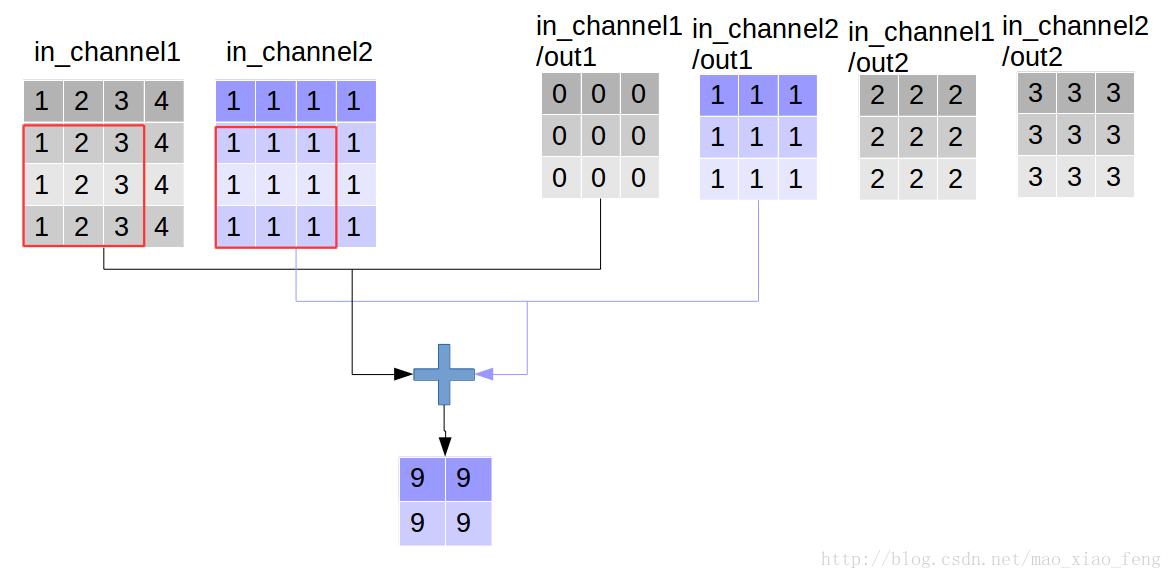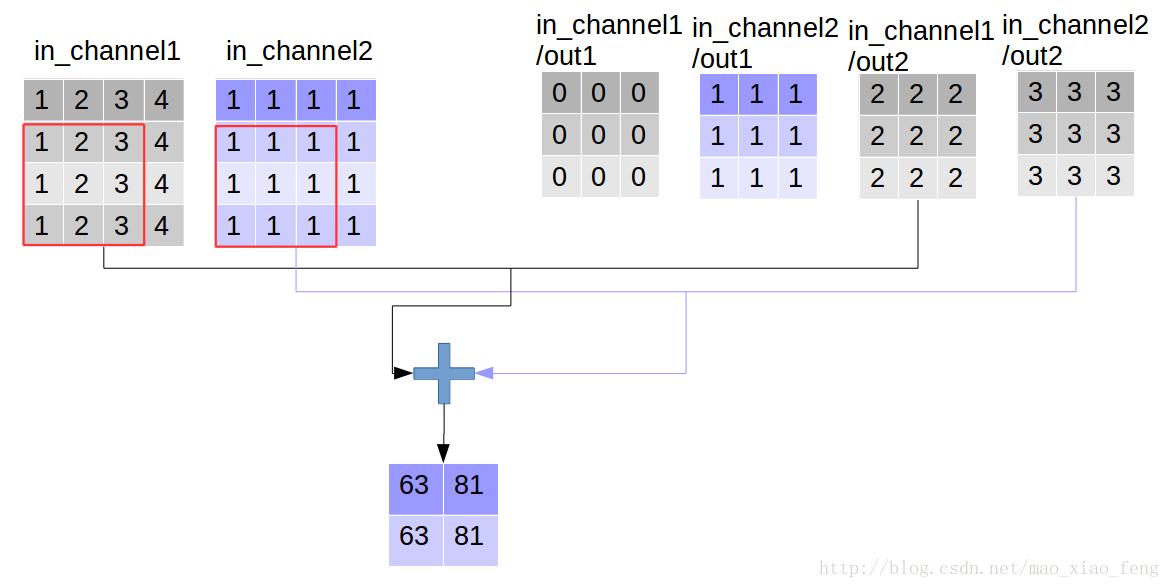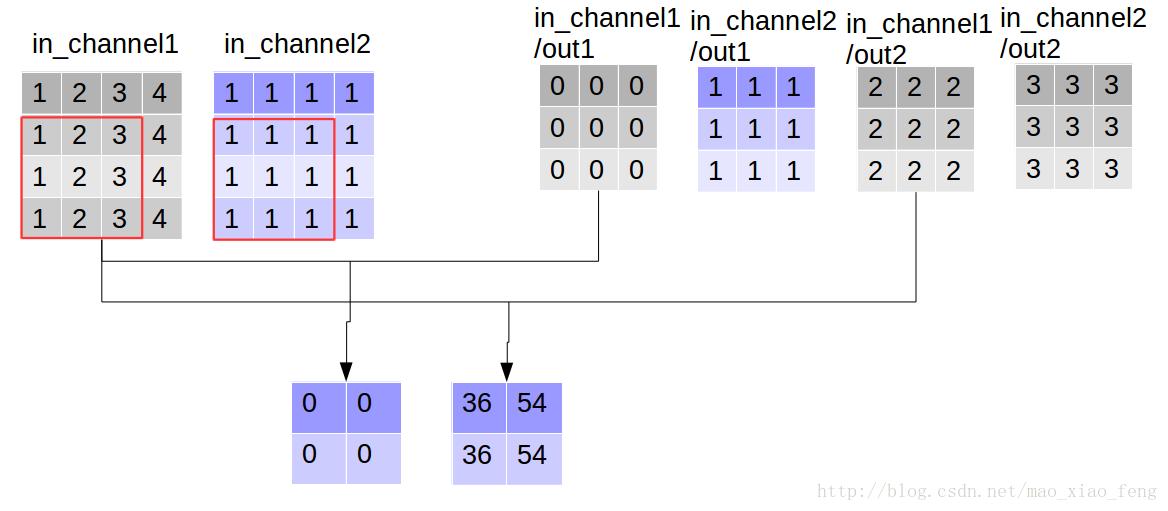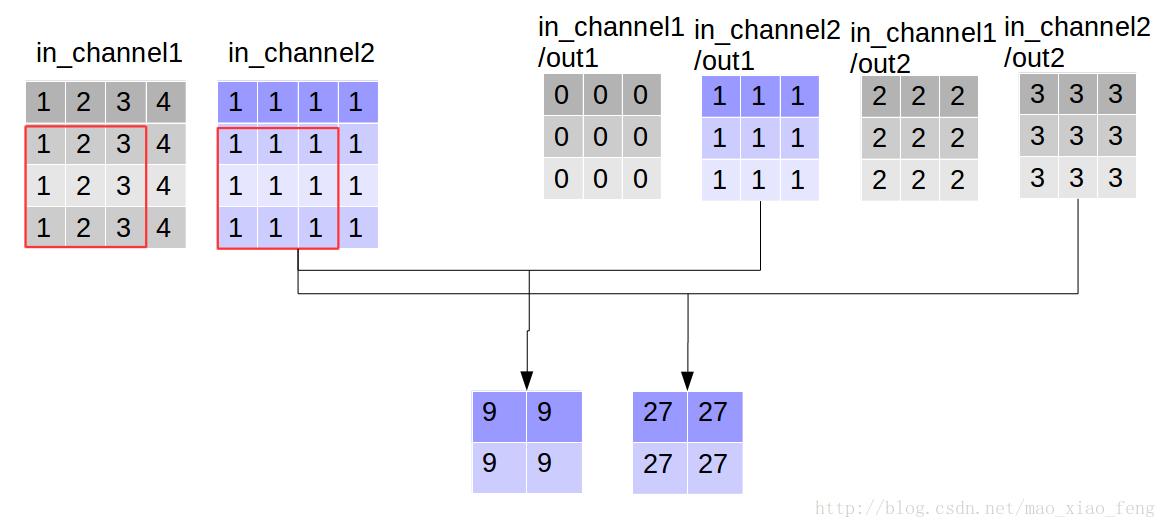实验环境:tensorflow版本1.2.0,python2.7
介绍
depthwise_conv2d来源于深度可分离卷积:Xception: Deep Learning with Depthwise Separable Convolutions
tf.nn.depthwise_conv2d(input,filter,strides,padding,rate=None,name=None,data_format=None)除去
name参数用以指定该操作的name,data_format指定数据格式,与方法有关的一共五个参数:input:
指需要做卷积的输入图像,要求是一个4维Tensor,具有[batch, height, width, in_channels]这样的shape,具体含义是[训练时一个batch的图片数量, 图片高度, 图片宽度, 图像通道数]filter:
相当于CNN中的卷积核,要求是一个4维Tensor,具有[filter_height, filter_width, in_channels, channel_multiplier]这样的shape,具体含义是[卷积核的高度,卷积核的宽度,输入通道数,输出卷积乘子],同理这里第三维in_channels,就是参数value的第四维strides:
卷积的滑动步长。padding:
string类型的量,只能是”SAME”,”VALID”其中之一,这个值决定了不同边缘填充方式。rate:
结果返回一个Tensor,shape为
[batch, out_height, out_width, in_channels * channel_multiplier],注意这里输出通道变成了in_channels * channel_multiplier实验
为了形象的展示
depthwise_conv2d,我们必须要建立自定义的输入图像和卷积核img1 = tf.constant(value=[[[[1],[2],[3],[4]],[[1],[2],[3],[4]],[[1],[2],[3],[4]],[[1],[2],[3],[4]]]],dtype=tf.float32) img2 = tf.constant(value=[[[[1],[1],[1],[1]],[[1],[1],[1],[1]],[[1],[1],[1],[1]],[[1],[1],[1],[1]]]],dtype=tf.float32) img = tf.concat(values=[img1,img2],axis=3)filter1 = tf.constant(value=0, shape=[3,3,1,1],dtype=tf.float32) filter2 = tf.constant(value=1, shape=[3,3,1,1],dtype=tf.float32) filter3 = tf.constant(value=2, shape=[3,3,1,1],dtype=tf.float32) filter4 = tf.constant(value=3, shape=[3,3,1,1],dtype=tf.float32) filter_out1 = tf.concat(values=[filter1,filter2],axis=2) filter_out2 = tf.concat(values=[filter3,filter4],axis=2) filter = tf.concat(values=[filter_out1,filter_out2],axis=3)建立好了img和filter,就可以做卷积了
out_img = tf.nn.conv2d(input=img, filter=filter, strides=[1,1,1,1], padding='VALID')好了,用一张图来详细展示这个过程


这是普通的卷积过程,我们再来看深度卷积。
out_img = tf.nn.depthwise_conv2d(input=img, filter=filter, strides=[1,1,1,1], rate=[1,1], padding='VALID')

现在我们可以形象的解释一下
depthwise_conv2d卷积了。看普通的卷积,我们对卷积核每一个out_channel的两个通道分别和输入的两个通道做卷积相加,得到feature map的一个channel,而depthwise_conv2d卷积,我们对每一个对应的in_channel,分别卷积生成两个out_channel,所以获得的feature map的通道数量可以用in_channel* channel_multiplier来表达,这个channel_multiplier,就可以理解为卷积核的第四维。代码清单
import tensorflow as tf img1 = tf.constant(value=[[[[1],[2],[3],[4]],[[1],[2],[3],[4]],[[1],[2],[3],[4]],[[1],[2],[3],[4]]]],dtype=tf.float32) img2 = tf.constant(value=[[[[1],[1],[1],[1]],[[1],[1],[1],[1]],[[1],[1],[1],[1]],[[1],[1],[1],[1]]]],dtype=tf.float32) img = tf.concat(values=[img1,img2],axis=3) filter1 = tf.constant(value=0, shape=[3,3,1,1],dtype=tf.float32) filter2 = tf.constant(value=1, shape=[3,3,1,1],dtype=tf.float32) filter3 = tf.constant(value=2, shape=[3,3,1,1],dtype=tf.float32) filter4 = tf.constant(value=3, shape=[3,3,1,1],dtype=tf.float32) filter_out1 = tf.concat(values=[filter1,filter2],axis=2) filter_out2 = tf.concat(values=[filter3,filter4],axis=2) filter = tf.concat(values=[filter_out1,filter_out2],axis=3) out_img = tf.nn.depthwise_conv2d(input=img, filter=filter, strides=[1,1,1,1], rate=[1,1], padding='VALID')输出:
rate=1, VALID mode result:
[[[[ 0. 36. 9. 27.]
[ 0. 54. 9. 27.]][[ 0. 36. 9. 27.]
[ 0. 54. 9. 27.]]]]到此这篇关于Tensorflow tf.nn.depthwise_conv2d如何实现深度卷积的的文章就介绍到这了,更多相关Tensorflow tf.nn.depthwise_conv2d深度卷积内容请搜索python博客以前的文章或继续浏览下面的相关文章希望大家以后多多支持python博客!
-
<< 上一篇 下一篇 >>
Tensorflow tf.nn.depthwise_conv2d如何实现深度卷积的
看: 1231次 时间:2020-07-17 分类 : python教程
- 相关文章
- 2021-12-20Python 实现图片色彩转换案例
- 2021-12-20python初学定义函数
- 2021-12-20图文详解Python如何导入自己编写的py文件
- 2021-12-20python二分法查找实例代码
- 2021-12-20Pyinstaller打包工具的使用以及避坑
- 2021-12-20Facebook开源一站式服务python时序利器Kats详解
- 2021-12-20pyCaret效率倍增开源低代码的python机器学习工具
- 2021-12-20python机器学习使数据更鲜活的可视化工具Pandas_Alive
- 2021-12-20python读写文件with open的介绍
- 2021-12-20Python生成任意波形并存为txt的实现
-
搜索
-
-
推荐资源
-
Powered By python教程网 鲁ICP备18013710号
python博客 - 小白学python最友好的网站!